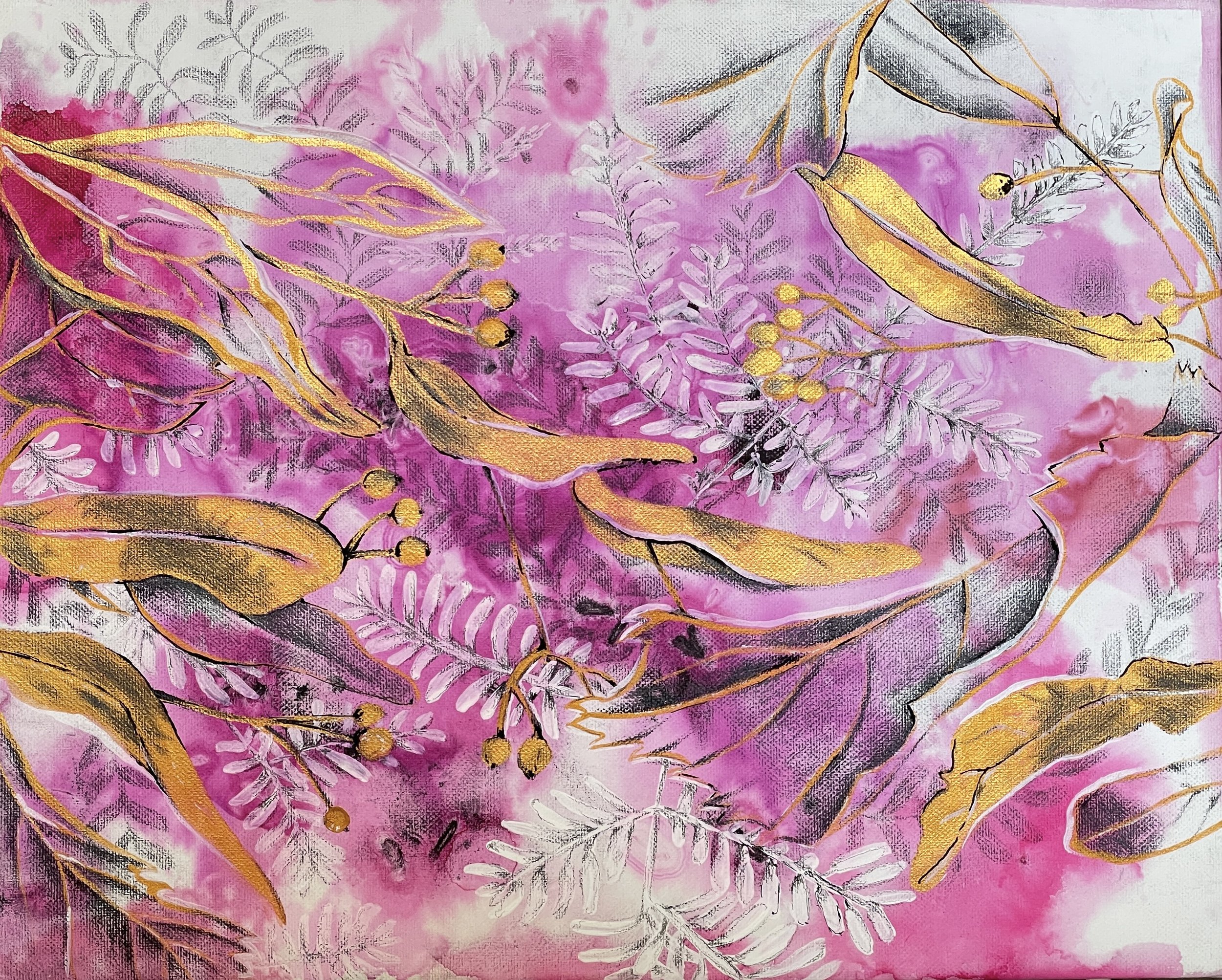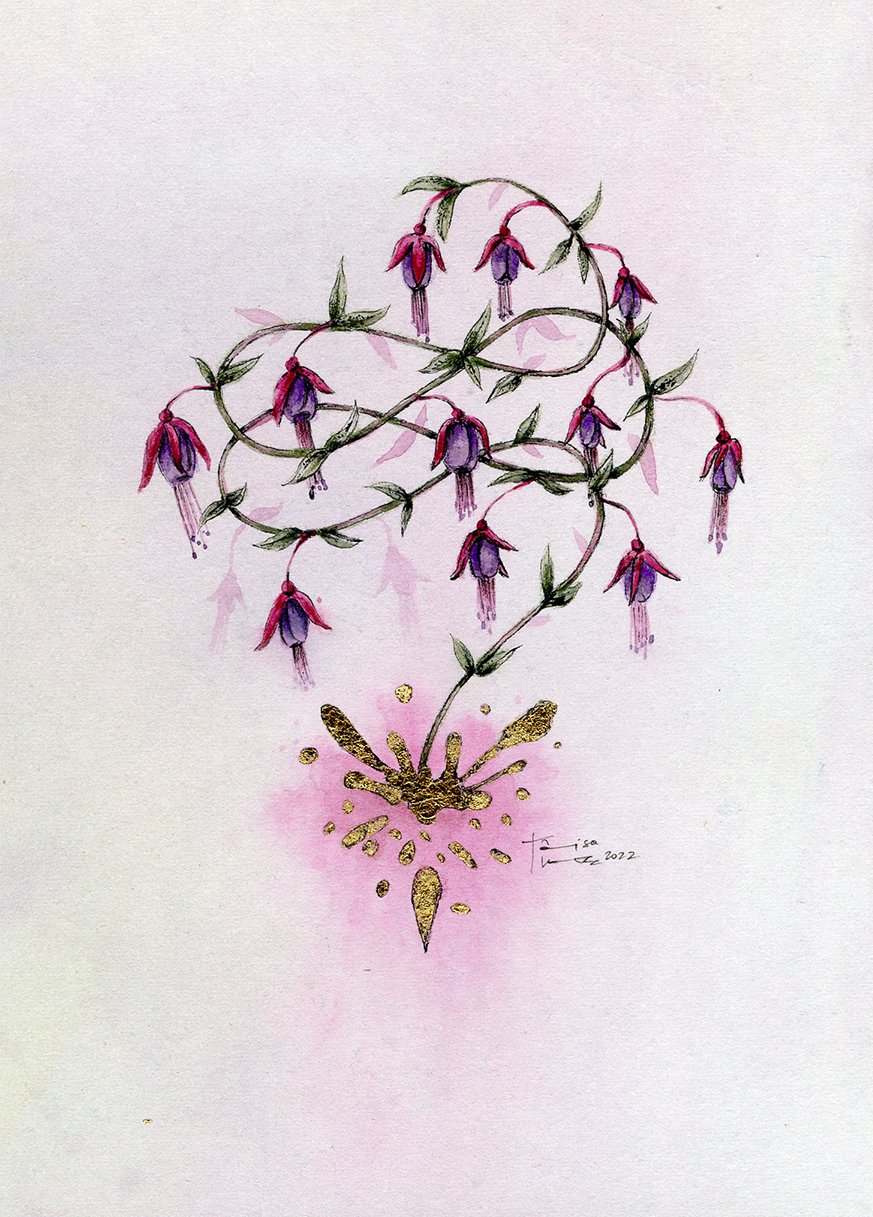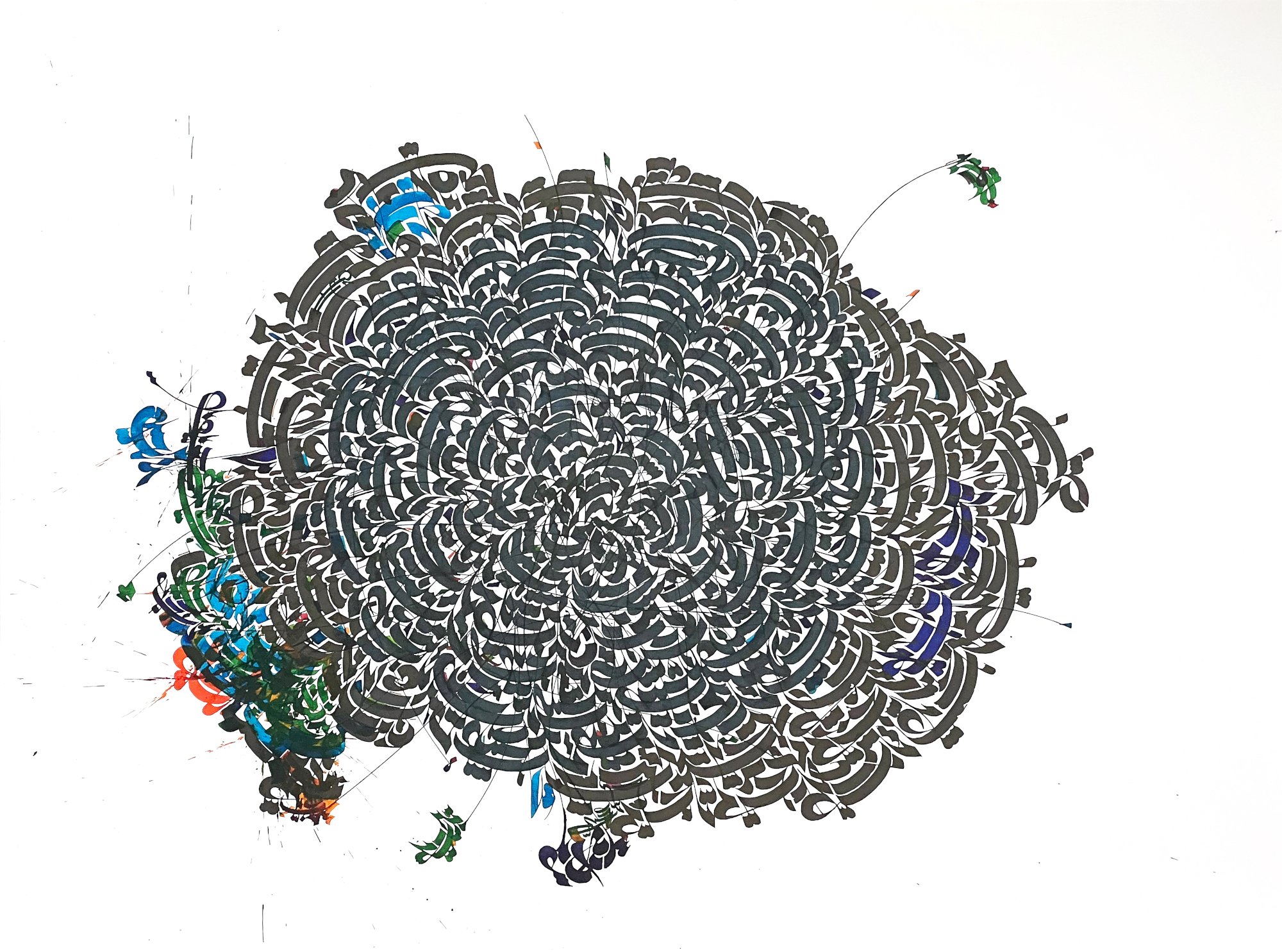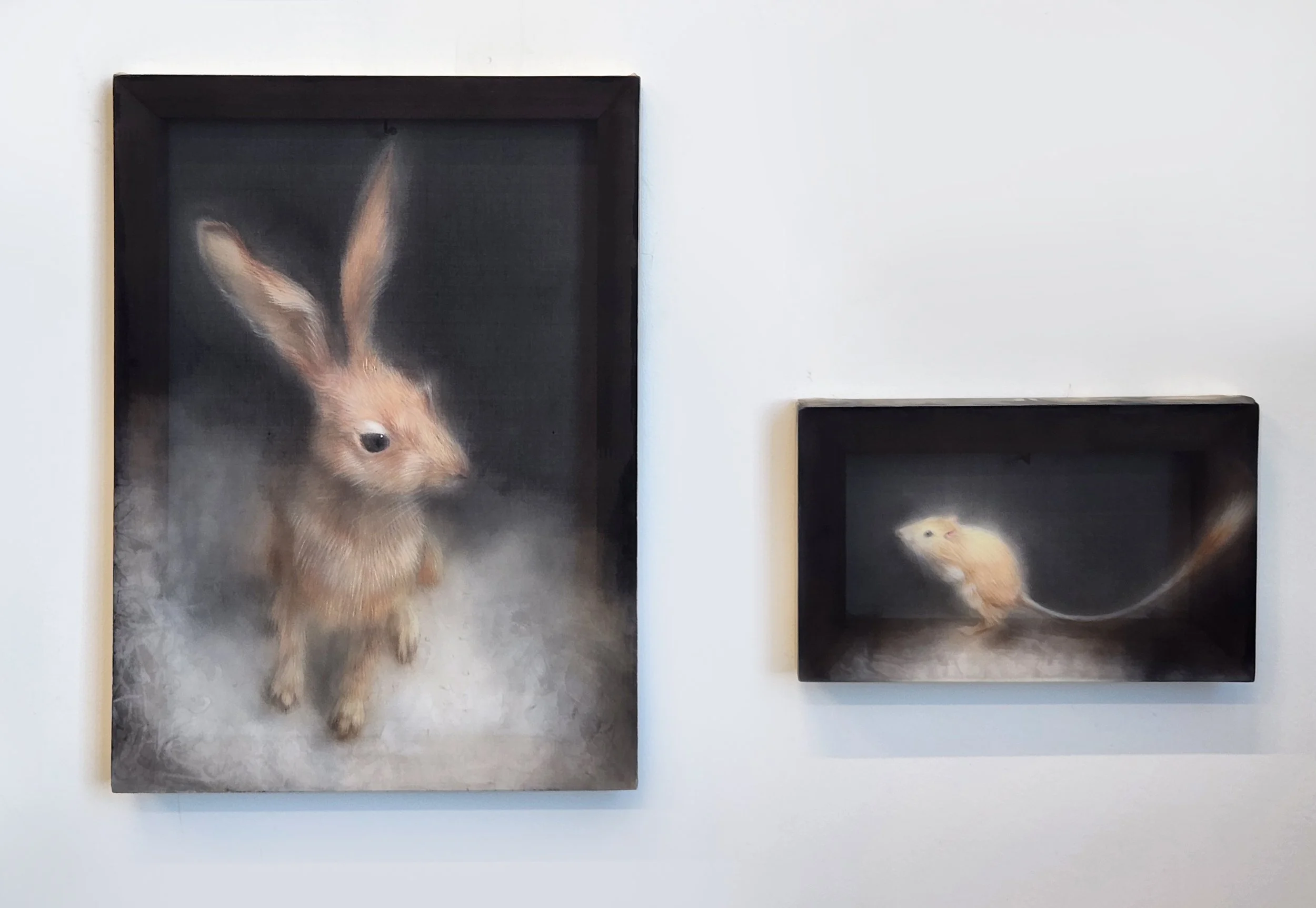10 Questions with Tâmisa Trommer
Tâmisa Trommer is an award-winning artist, known for her mixed media delicate botanical signature. Born in Brazil in 1985, she reinterprets her understanding of life after tragic family events, strengthening her sensitive and escapist personality. Currently residing in Italy, she finds inspiration in idyllic landscapes to create her latest artistic body of work, exploring intertwined life cycles with her personal memories.
Her works are part of the permanent collection of the Brazilian Museum of Engraving and have been exhibited in prestigious Brazilian institutions such as SESC Avenida Paulista, SESC Pompeia, and Centro de Cultura Mário Quintana. Additionally, she has exhibited at biennales such as Recôncavo Baiano (BR), Olho Latino (BR), and the London Biennale (UK). Among her awards, she has won 1st place at SESI Descobrindo Talentos (BR), 2nd place at “The Magic of Transformation” (UK), and was nominated by Itaú Cultural as one of the outstanding artists from Brazil.
Tâmisa holds a Bachelor’s degree in Visual Arts from UFSM, one of the most prestigious educational institutions in Brazil, and two post-graduations, one in Surface Design, also from UFSM and the other in Design from UNIRITTER (BR). The artist is versatile, working across various mediums such as painting, drawing, mural art, illustration and photography.
Tâmisa Trommer - Portrait
ARTIST STATEMENT
As a Brazilian artist living in Italy, Tâmisa’s research delves into representing the passage of time and her identity through flora. Inspired by childhood memories that comforted her during moments of grief, she finds in autobiographical events the inspiration to create floral compositions and bucolic scenes with a dreamy atmosphere, transitioning between figuration and abstraction.
The duality of life cycles shines through the juxtaposition of botanical elements, which carry the symbolism of a deconstructed personal diary. A nostalgic tone permeates her work, marked by the fusion of drawing and painting techniques reminiscent of the artistic materials she learned as a child, and which still today serve as an extension of her voice. In the color palette, she highlights various shades of pink, representing coziness, innocence, and resilience. The use of gold leaves, susceptible to oxidation, symbolizes the passage of years, emphasizing chance and the ephemeral nature of life.
By sharing her experiences expressed through the titles of the artworks and the carefully chosen flora, Trommer’s aim is to inspire the audience to reflect on their own experiences, question the fluidity of memories, their interpretations, and the imagination that permeates them. In the end, each artwork comes to life through the viewer’s individual perspective, exploring the multiple layers of the human experience and our relationship with nature and time.
It's not a princess earing, watercolor, gouache and graphite on canvas, 30 x 24 x 2 cm, 2023 © Tâmisa Trommer
INTERVIEW
First of all, introduce yourself to our readers. What is your artistic background and how did you start experimenting with images?
I'm Tâmisa Trommer, a Brazilian mixed media painter living in Italy. My artistic journey started when I was 11 years old when I asked my mother to study painting and drawing. That occurred after a car crash I had with my family, which made me understand how life is delicate and finite, so every day counts and I need to feel that I truly lived it.
I was a very shy kid, so canvas and paper were the places I could express myself. I always felt it like my safe space, where I could be dreamy, funny, acid, bitter, nostalgic, experimental and speak my truth. So, it is no surprise that I chose Fine Arts to graduate. However, after I finished my Bachelor's Degree, I was too young and uncertain of how to proceed, so I decided to postgraduate in Surface Design and go for a commercial approach to complement my graduation.
My academic background in Fine Arts and Surface Design, followed by two internships as an art educator at the "Bienal de São Paulo" and "Bienal do Mercosul," gave me the experience to start teaching Arts, Design, and Photography. I worked at some established schools in the south of Brazil for seven years, which also directed me to do my master's in Design.
Unfortunately, in 2012 my father passed away. This traumatic event made me review my life and come to the conclusion that, even though I liked to be a teacher and was grateful for it, that alone wasn't fulfilling me. Also, considering I feel the urge to make everyday worth, I had to change… and when we realize it, there is no turning back.
So, after I finished my Master's in 2016, I stepped back from my full-time teacher position and opened my own art studio to work with commissioned paintings and commercial illustrations. Since then, I have committed to becoming an artist who knows how to run their own business on all fronts, which is way beyond artistic skills. This journey of almost eight years also brought me back to the contemporary art world with the certainty that I was where I was supposed to be and that I was confident about the role of my artwork in the world.
(Im)perfect, watercolor, gouache, pastel and graphite on canvas, 50 x 70 x2 cm, 2023 © Tâmisa Trommer
Why are you an artist, and when did you first become one?
I believe that making art is my second language, so I became an artist in high school when I created my first series of drawings and watercolor paintings, exploring the duality between life and death besides raw emotions such as pain, solitude, and abandonment. That moment was the first time I used my own story as a creative driver, but I was too young and inexperienced to see the bigger picture about what is the role of an artist in the world.
Only during my grief did I understand the power of the message art can carry and how I could bring a positive message to the world. That period I shifted my aesthetics to more light, solar, colorful art pieces, focusing at being a drop of joy even for the most tough days.
You are originally from Brazil, but you are currently living in Italy. How did this move influence your work?
Moving to Italy has had a significantly higher impact on my artwork than I first imagined. This is especially true because when we—my husband, our dog, and I—moved to Bergamo, our intent was to change habits, live a different cultural experience, and better balance work and life. Also, in Brazil, I used to work mostly for commercial purposes, but I felt the urge to prioritize my own research and saw in this change an opportunity to "start over."
The first months were hard because I dug deeper into memories and emotions and reviewed the way I was leading my art career. That said, the city I live in today is 10x smaller than where I lived before and, at the same time, Bergamo has more than twice the age of Brazil, so here I witness the respect the Italians have for their history and art.
Also, I have my feet in the mountains, surrounded by nature and parks, got to know so many different flowers that I never imagined, and experience and understand better the changes of the four seasons through the year that are much more clear than what we have in Brazil. So, moving to another country and feeling as "an outsider" reinforced what is important to me, and that itself is revealed in my artwork.
You primarily work with painting, both on canvas and as murals. Why did you choose this medium specifically?
Painting allows me to feel expressive, I can use my full body as a tool to do my work, so it is about the energy that the painting act carries.
Also, as a very nostalgic person, I'm moved by childhood memories, like when I collected stationery writing paper illustrated with watercolors paintings, or by objects I used to be surrounded at my family's home like tapestry, hand-painted porcelain, landscape watercolors art. That aesthetic makes me feel cozy and in a safe place to express myself.
The murals have a similar motivation: to extend the feeling of belonging and to reinforce what matters to those who commission my artwork. It's like translating the idea of a dreamy landscape into a space to play with perspective and feel inside a fairy tale.
Rain, watercolor, china ink and gilding on paper, 22 x 27 cm, 2022 © Tâmisa Trommer
Unicity, watercolor, gouache, pastel, graphite, graffiti and gilding on paper, 50 x 70 cm, 2023 © Tâmisa Trommer
Can you tell us about the process of creating your work? How do you go from the first idea to the final outcome?
It all starts like a dream. Sometimes I read or listen to something that inspires me or literally I dream about what I should paint. Suddenly it becomes an image, a visual anticipation of what I am supposed to do.
Sometimes I make sketches, other times a full digital project (specially for commissions that require approval from the client before painting). But also there are times when I just go and paint with the flow, guided by the image I have in mind, but flexible with what happens on the way.
Specifically for my own research, the next step is to transform that idea into abstract stains for the background, exploring the energy and emotions, playing with colors and movement, just open minded about the result. After that, I choose some photos, between my own personal archive that has about 20 years of nature pictures.
These images are the reference for my painting and drawing and are chosen to fit with the background. Like a "collage" of my experiences, abstracted from the flowers I have seen, I look beyond the image, remembering where I was and what I was living and feeling when I made it. The memories and emotions guide me. Overall, each piece is like a wine that needs its own time, as well as the techniques and materials that are responsible for communicating the primal idea of the art piece.
What themes do you pursue with your work?
Curiously through all my career – and here I include my pre academic production – I kept the same core theme which is how time is revealed as a marked memory, usually considering nature as the revealer. As an example, abandoned places, a paint exposed to the weather, plants that are born in unwanted - or unimaginable - places.
A second topic is the paradox between beauty and value, which has a direct connection with how we, as an western society, decide what has and hasn't value, and underappreciate scars or life body marks. Also, I'm captivated to keep my artworks between abstract and figurative with a hint of pattern design, inspiring the spectator to dream and create its own narrative.
And finally, the most recent subject is ambiental sustainability, which somehow was ever there, but got stronger since I opened my art studio and started studying botanics. Learning about biodiversity, botanical blindness, alien plants and endangered species inspires me in my own creative process and drives me to explore our role with nature and future generations.
It is not a love letter, watercolor, gouache, pastel, graphite and gilding on paper, 40 x 50 cm, 2023 © Tâmisa Trommer
What's the essential element in your art?
Absolutely the color pink. I have been obsessed with it for about 20 years now and, since I arrived in Italy, decided that my artwork must have pink to be true to myself.
I love the richness of the shades of pinks, despite not having a proper spot at the wheel of colors. This color can represent every moment of our lives, bitter and sweet and overall for me it represents: welcoming, fantasy, innocence, delicacy, boldness, warmth, kindness and family.
Unfortunately, it's a color that has a lot of superficial assumptions, but I'm willing to help break it down.
How do you promote your work? And how do you keep your followers engaged?
I use omnichannel strategies to promote my work. Specifically, since I moved, I've been facing some cultural differences in how Italians and Europeans relate to art and social media, which isn't so similar to Brazilians. That said, I'm very engaged in producing my own exhibitions and approaching brands and galleries.
Also, I regularly visit art fairs, which allows me to meet new gallerists and artists. Frequently, I make partnerships with architects and decorators. Right now, I'm looking to be part of artistic associations in the North of Italy and share an atelier so I can be closer to the local artistic community.
About the online approach, besides updating my website regularly and social media, I am part of some online European galleries and projects. From time to time I participate in podcasts and interviews. And to find new opportunities, I engage in open calls for residencies, art fairs, group exhibitions, live painting and murals.
To keep the community – the Pinkish, as I call them – engaged, I like to be transparent with my thoughts, tell what is important in my work and point of views in life. Also, I am dynamic in how I show my work on social media, bringing a little bit of my artwork and things I like, what I do, places I visit and the importance of my family, so they can feel like they are with me, sharing these experiences.
I consider it extremely important to create a dreamy space on my social media, where people feel like an escape from daily life problems, it's a safe and cozy space to be.
Power, watercolor, gouache, pastel, graphite and gilding on paper, 35 x 50 cm, 2023 © Tâmisa Trommer
What do you think about the art community? Do you feel you have found your place there?
Bergamo is already my home; it is a lovely historic city with a lot of nature, and it is easy to connect to other bigger places where there are important contemporary art events. So far, I'm still getting to know the local art community – learning the Italian language "piano piano," as they say here –but I always felt very welcome and respected. Also, there is a sea of opportunities, which reinforces this is the place to be.
Finally, any projects you are looking forward to for this year?
The most important is to enroll in a Master's in Painting in Bergamo. For other projects, I want to expand the visibility of my work - painting and murals - to other European countries as well as be part of at least one artistic residency.
Artist’s Talk
Al-Tiba9 Interviews is a promotional platform for artists to articulate their vision and engage them with our diverse readership through a published art dialogue. The artists are interviewed by Mohamed Benhadj, the founder & curator of Al-Tiba9, to highlight their artistic careers and introduce them to the international contemporary art scene across our vast network of museums, galleries, art professionals, art dealers, collectors, and art lovers across the globe.





















